5 Trending Tropical Fruit Blends for Functional Beverages for 2026
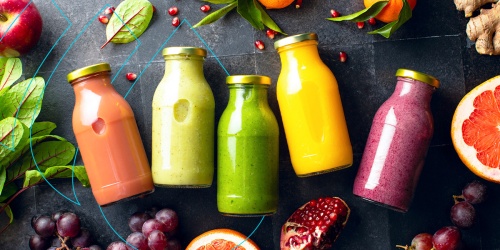
Consumers no longer simply reach for refreshment. They want beverages that deliver bold experiences, support their wellness goals and contain ingredients they recognize and trust. Functional beverages meet this demand, with an exciting crossover between adventurous flavors and nutrition.
Tropical fruit blends are leading this transformation, bringing vibrant colors, complex flavor profiles and built-in functionality that naturally aligns with consumer demands. From passion fruit's exotic tang to coconut water's clean hydration, these ingredients offer manufacturers powerful tools for innovation.
Why Tropical Fruit Blends Are on the Rise
The fruit beverages market is expected to grow from $50 billion in 2025 to $74 billion by 2035, with the United States expected to be the most lucrative market. The surge in tropical fruit blends reflects a fundamental shift in how consumers approach beverages. Understanding these drivers helps manufacturers position their products effectively in a competitive landscape.
Health and Wellness
The wellness movement has transformed beverages from simple refreshment into functional delivery systems. The $149.75 billion U.S. functional beverage market is forecast to reach $248.51 billion by 2030, growing at an 8.9% CAGR.
Product developers are increasingly turning to tropical ingredients for their natural nutritional and functional benefits. Fruits such as passion fruit, guava, mango, acerola, dragon fruit and coconut water offer a range of desirable attributes that make them appealing in formulation:
- Passion fruit: Delivers an exotic, bold flavor and vibrant orange color
- Guava and mango: Provide natural sweetness, balanced acidity and antioxidant appeal
- Acerola: Offers a concentrated source of natural vitamin C to support immune health
- Dragon fruit: Adds striking color and is rich in antioxidants
- Coconut water: Serves as a clean-label hydration base, naturally rich in electrolytes
The evolution of natural functional beverages continues to accelerate, driven by demand for scientifically backed wellness solutions. Natural functional drinks are increasingly incorporating ingredients like adaptogens and nootropics to support mental clarity, reduce stress and enhance mood. Tropical fruits complement these functional ingredients, masking bitter or earthy notes while contributing nutritional benefits.
Global Flavor Adventure
Today's consumers demand globally inspired tastes that transport them beyond the familiar. Shoppers actively seek new experiences through their beverage choices, viewing each purchase as an opportunity for culinary exploration.
In response to changing palates, tropical fruit sourcing has evolved from commodity procurement to a storytelling opportunity. Brands are accessing fruits from specific regions known for superior quality, as single-origin ingredients tell compelling stories that resonate with consumers. Brazilian açaí, Vietnamese dragon fruit and Philippine coconut water each bring unique flavor profiles and cultural narratives that enhance brand storytelling.
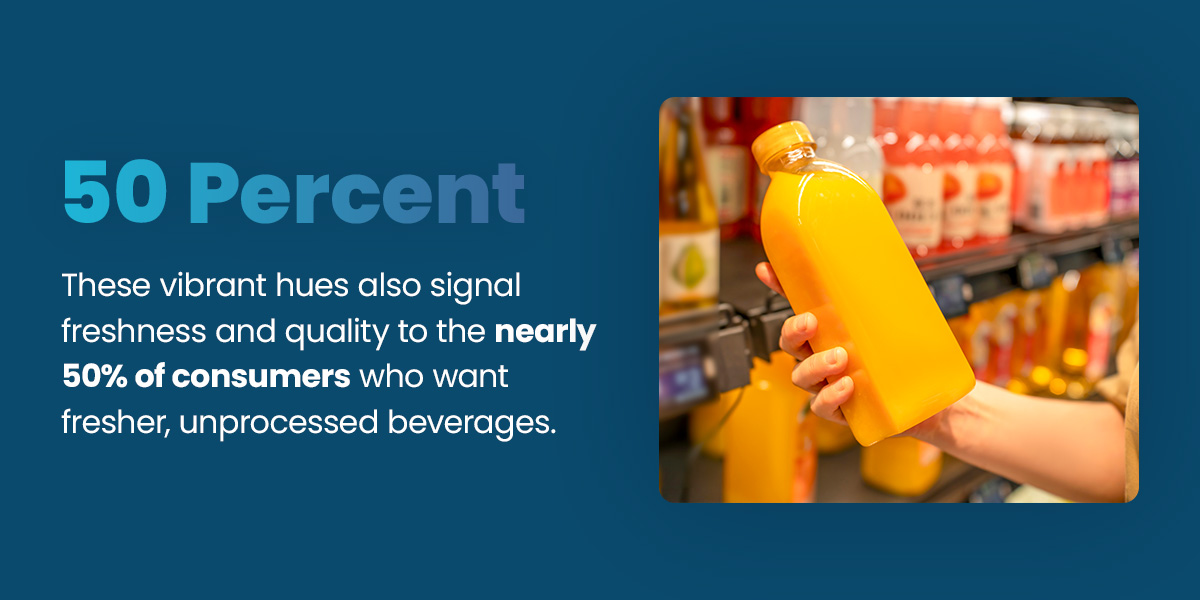
Visual Impact
The Instagram, Pinterest and TikTok generation demands beverages that photograph well and look cinematic in video. Tropical fruits offer stunning natural colors that eliminate the need for artificial dyes, providing a striking visual differentiation that boosts appeal on the shelf. These vibrant hues also signal freshness and quality to the nearly 50% of consumers who want fresher, unprocessed beverages.
Social media has amplified this trend. The way tropical beverages pour, layer and mix creates dynamic experiences that encourage social sharing and brand engagement. This visual virality drives trial among younger demographics who discover products through peer recommendations rather than conventional advertising.
Clean Label
The clean label movement has changed beverage formulation. Consumers scrutinize ingredient lists, seeking products with recognizable ingredients and minimal processing. Tropical fruits excel in this environment. They offer natural sweetness, color and nutrition without requiring extensive modification or artificial enhancement.
Better-for-you beverages must strike a balance between functional efficacy and label transparency. Tropical fruits provide this balance naturally. For example, their natural sugar content provides sweetness without the need for added sweeteners, which wellness-focused consumers typically avoid.
Many tropical fruits naturally contain higher levels of acidity, which can help enhance product stability and lessen the need for added acids or preservatives. Their vibrant, well-balanced flavor profiles enable formulators to create bold, authentic taste experiences with less reliance on artificial flavors or additional sugar.
Versatility
Tropical and exotic fruits bring unmatched versatility to the natural functional beverage space, bridging the gap between appealing flavor and multifunctional formulation potential. Their adaptability across beverage types — from hydration drinks and smoothies to teas, tonics and energy water — makes them highly valuable to brands seeking both functionality and sensory appeal.
Tropical fruits can be incorporated as purees, concentrates, powders or extracts, enabling flexibility for both still and sparkling applications. They also align well with plant-based and reduced-sugar trends, naturally enhancing sweetness and mouthfeel without added sugars or artificial flavor systems.
From a functional standpoint, tropical fruits deliver a range of nutrients that support key wellness positioning. Their broad nutritional range allows formulators to align different fruits with specific health benefits while maintaining a natural, recognizable ingredient story that resonates with label-conscious consumers.
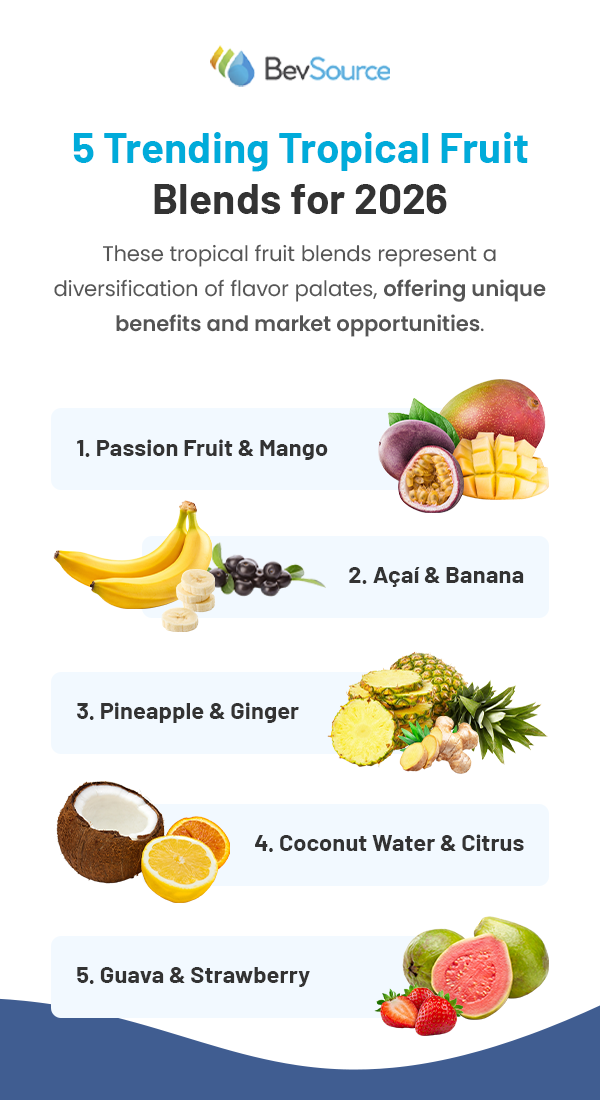
5 Trending Tropical Fruit Blends for 2026
These five tropical fruit blend trends represent a diversification of flavor palates, offering unique benefits and market opportunities.
1. Passion Fruit-Mango
This powerhouse pairing dominates premium juice categories and functional beverages. Both fruits bring intense, complementary flavors that provide complexity without overwhelming the palate. Passion fruit's tart, floral notes balance mango's creamy sweetness, resulting in a mouthwatering profile.
The combination delivers exceptional levels of vitamin C, supporting a robust immune system. Mango contributes vitamin A and fiber, while passion fruit adds beneficial plant compounds, including flavonoids and phenolic acids. Together, they form a nutritional powerhouse.
This blend is perfect for the following functional beverage formats:
- Flavored sparkling waters
- Energy drinks
- Yogurt drinks and smoothie bases
2. Açaí-Banana
A superfruit meets a familiar staple in this trending combination. Açaí's reputation as an antioxidant powerhouse continues to drive consumer interest, while bananas provide natural sweetness and body that improve mouthfeel without added sugars.
Açaí is perfect for health drinks and smoothies. Its deep purple color signals the presence of anthocyanins, the phytochemical that gives the berry its purplish-red color. These compounds are widely known for their health benefits in preserving cell integrity by protecting cells from free radicals, which is linked to improved cardiovascular health and cognitive function. Bananas' potassium supports muscle recovery and electrolyte balance. The combination also provides sustained energy through natural sugars and fiber, avoiding the spike-and-crash associated with added sweeteners.
The açaí-banana blend is best used in the following:
- Ready-to-drink protein shakes
- Frozen blends like smoothie ice cubes
- Plant-based milk alternatives
3. Pineapple-Ginger
This tropical twist pairs pineapple’s bright, familiar sweetness with ginger's spicy kick for refreshing drinks that deliver functional benefits and broad appeal.
The pairing supports multiple functional health benefits. Pineapple is rich in vitamins, minerals and antioxidants and offers numerous health benefits, including aiding digestion, boosting immunity and supporting heart and skin health. Ginger's reputation for settling stomachs and reducing nausea makes it ideal for digestive health positioning. Together, they help beverages feel indulgent and therapeutic.
Functional shots maximize this blend's potency in convenient, on-the-go formats, while sparkling waters capture its refreshing character. Kombucha and other fermented beverages benefit from ginger's ability to complement fermentation flavors while pineapple brightens and sweetens the overall profile. The pineapple-ginger combination also excels in mocktails.
4. Coconut Water-Citrus
Clean hydration meets bright refreshment in this naturally functional pairing. Coconut water is packed with natural essential electrolytes like potassium, magnesium and calcium. Adding citrus enhances flavor appeal with its bright, refreshing notes and contributes vitamin C.
This combination addresses the growing demand for better-for-you beverages that deliver function without artificial ingredients. The naturally low calorie count appeals to health-conscious consumers, while the electrolyte content attracts active individuals. Citrus varieties, from lime to grapefruit, allow for flavor customization.
Ready-to-drink (RTD) sports drinks are a popular application of this tropical fruit blend. Morning hydration drinks, low-alcohol and alcohol-free cocktail mixers, and wellness shots are also premium, convenient formats.
5. Guava-Strawberry
This emerging combination strikes a balance between familiar and exotic. Strawberry's universal appeal makes guava more approachable for consumers new to tropical flavors, while guava adds complexity that elevates strawberry.
Guava delivers an exceptional amount of vitamin C. Its pink-red color comes from lycopene, the same antioxidant found in tomatoes. Strawberries contain anthocyanins and ellagic acid, compounds that have been studied for their potential cardiovascular and cognitive benefits. Together, they form an antioxidant profile that creates the ideal wellness beverage.
The guava-strawberry blend can be used in various formats, including:
- Concentrated wellness shots
- Sparkling drinks
- Enhanced waters
- Energy drinks
- Probiotic beverages
How to Bring These Tropical Blends to Market
Success with tropical fruit blends requires strategic thinking beyond flavor selection. These proven approaches help companies navigate development challenges while maximizing market opportunities.
Experiment With Niche Pairings
Standing out requires moving beyond expected combinations. Consider pairing tropical fruits with unexpected ingredients to create unique sensory experiences. Tropical fruit beverages blended with herbs like basil or cilantro can be fun and sophisticated. Spices such as cardamom and black pepper add complexity.
Some standout examples include:
- Passion fruit and hibiscus
- Mango and turmeric
- Pineapple and basil or mint
- Guava and ginger
When introducing unfamiliar tropical fruits, balance them with recognized favorites. A dragon fruit-apple blend feels more approachable than pure dragon fruit. This strategy reduces consumer hesitation while expanding flavor horizons.
Focus on Format
Format selection plays a critical role in product formulation and performance. Tropical fruits are available in several formats, each offering unique benefits for stability, flavor and nutrition:
- Purées: Provide authentic fruit character and vibrant flavor, but may have limited shelf life
- Concentrates: Offer cost-effective, customizable solutions, but require careful dilution to maintain flavor balance
- Powders: Deliver portability and extended shelf life, but must preserve flavor integrity through processing
Choosing the right ingredient format based on processing needs and target product requirements ensures an optimal tropical experience and successful product outcomes.
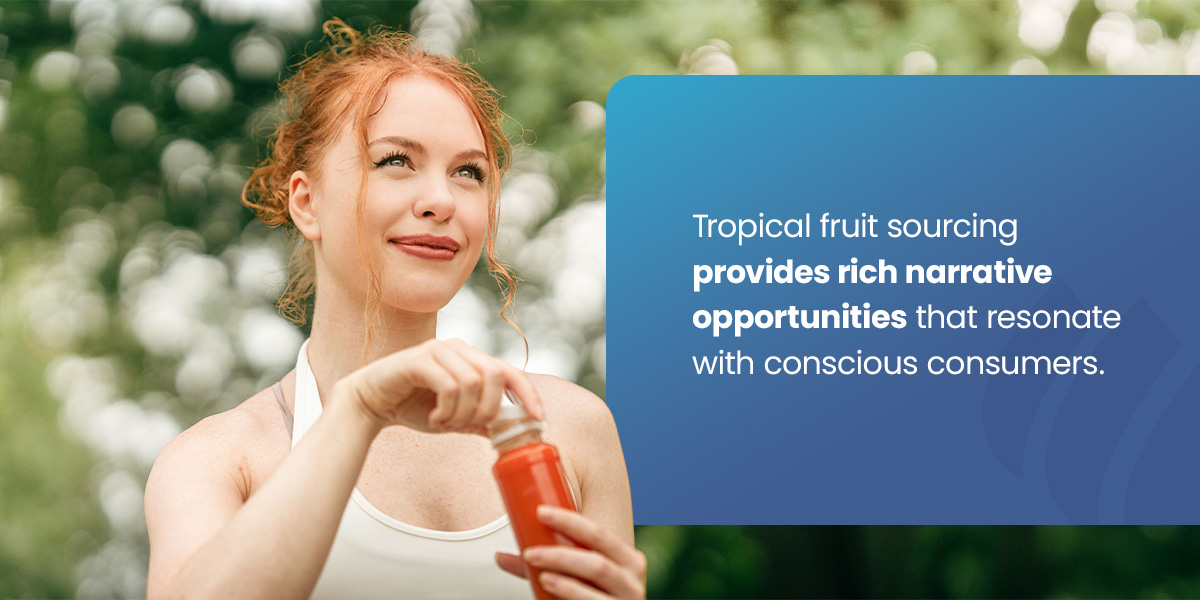
Lean Into Sourcing Stories
Tropical fruit sourcing provides rich narrative opportunities that resonate with conscious consumers. Single-origin ingredients command premium prices while supporting transparency. Partnership stories with farming communities add an emotional connection.
Sustainability credentials increasingly matter in purchase decisions. Organic certification, fair trade partnerships and regenerative agriculture practices differentiate products in crowded categories. Document your supply chain journey, from grove to glass, developing content that engages consumers beyond the point of sale.
Don't Forget Color and Visual Appeal
Visual impact encourages interest, especially among younger consumers who share beverage experiences on social media. Natural color variations between batches can enhance perceptions of authenticity when properly communicated. Consider how colors interact in multi-layer drinks or color-changing formulations that result in memorable experiences.
Packaging design should celebrate tropical vibrancy without overwhelming the consumer. Clear bottles showcase natural colors, but protecting light-sensitive nutrients requires specific solutions. Consider how beverages photograph under different lighting conditions, optimizing for both retail environments and social media sharing.
Tropical Fruit Blend Beverages FAQs
Here are answers to a few common questions to help you develop a tropical blend beverage that stands out in the market:
How Much Do Tropical Fruit Ingredients Cost Compared to Domestic Fruit Ingredients?
Tropical fruit ingredients often cost similarly to domestic fruit ingredients because even local fruits are frequently imported as juices, purees or concentrates. Large-scale processing facilities abroad provide consistent quality, meet various certifications — organic, Kosher and non-GMO — and handle high volumes efficiently. As a result, juices and juice products from both tropical and domestic fruits can have comparable costs, with price driven more by processing, logistics and certification requirements than by the fruit's origin.
Can Tropical Fruit Blends Mask the Taste of Functional Ingredients?
Yes. Tropical beverage ingredients excel at masking challenging flavors, such as those from adaptogens or probiotics. Tropical fruits are usually sweet, which can conceal bitter compounds. The key is matching flavor intensity to develop a beverage that's functional and tasty.
What Certifications Should Brands Consider When Sourcing Tropical Fruits for Beverages?
Priority certifications include USDA Organic for premium positioning, Non-GMO Project Verified for clean label claims and Fair Trade for ethical sourcing stories. Rainforest Alliance Certification resonates with environmentally conscious consumers. The Safe Quality Food certification, as well as the Brand Reputation Compliance Global Standards certification, ensure quality supplier systems. Consider options such as kosher or halal to expand your market access.
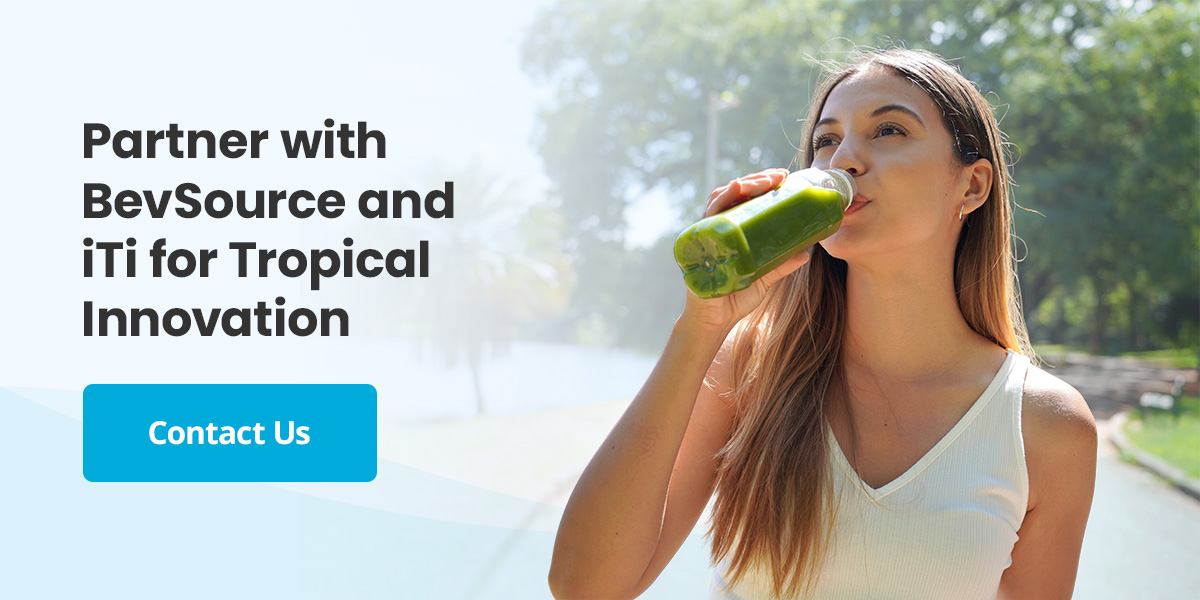
Partner With BevSource for Tropical Innovation
The tropical fruit beverage market presents a significant opportunity for brands. Developing market-ready tropical beverages requires deep expertise across formulation, sourcing and production. Working with an expert beverage development partner ensures innovative formats, optimal color selection, strategic tropical fruit sourcing, controlled costs and accelerated launches.
BevSource offers an integrated solution for developing tropical beverages through our sister company, iTi Tropicals. With over 30 years of expertise in sourcing tropical fruits and comprehensive formulation capabilities, we transform concepts into market-ready products.
Our comprehensive services include access to premium tropical ingredients, the largest copacker network in North America and proven processes that minimize risk while accelerating speed to market. Contact us today to explore how our integrated capabilities can bring your vision to life.
